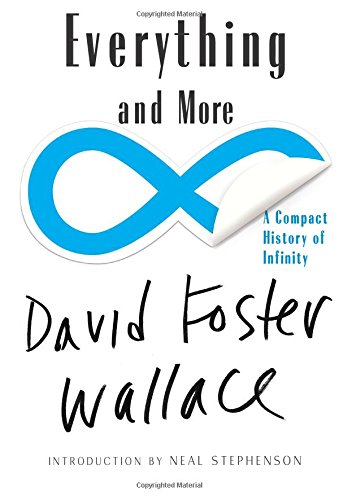Everything and More is a non-fiction novel about the history and understanding of infinity in mathematics. It was written by renowned post-modern novelist David Foster Wallace. It was part of a series of novels about science and mathematics, commissioned by the publisher W.W Norton, called "Great Discoveries"—the intention of which was to allow contemporary fiction writers to take on such subjects. I haven't read any other books in the series, but if Everything and More was any indication, they probably should've left the technical writing to the experts.
David Foster Wallace is well known for his diverse writing style and distinctly post-modern techniques. This includes the rampant use of acronyms and abbreviations, footnotes, and what I would call "flexible prose", i.e the use of unique words and phrases, non-conventional syntax and semantics, liberal re-purposing of punctuation and run-on sentences like this one.
It's unfortunate that Wallace decided that writing a non-fiction novel about an immensely complex and intricate subject was no reason to change this style.

The purpose of a book like this should be to confer a greater understanding of the subject matter, and illuminate the significance of the subject to the reader. By not sacrificing his artistic integrity for the sake of clarity, I feel that DFW has lost on both fronts in this case. I would've gained more from reading a conventional text on infinity in math, of which there are a multitude.
I'm probably in a better position than most to have enjoyed this book, seeing that I was exposed to some pretty advanced math during my undergraduate studies, so a lot of the concepts and arguments Wallace referenced were already familiar to me. For someone without a math background, I can imagine it'd be a nightmare trying to comprehend the math while having to parse Wallace's writing as well. Therefore, as much as I didn't enjoy the book, I'm confident most readers would enjoy it much less.
Despite learning about some of these mathematical concepts in school, I'm by no means in any position to critique the veracity of Wallace's proofs and explanations. However, from reading a couple reviews by people who are more qualified to critique it, it sounds like there are quite a few mathematical inaccuracies. Both reviewers were also in agreement that the writing comes off as unnecessarily confusing. I tend to agree.
Introductions
One of my favourite parts of the book was the introduction actually, written by science-fiction author Neal Stephenson. It was a light-hearted, intriguing explanation of Wallace's character and how he was influenced by his upbringing. Stephenson describes the cultural identity of an MACT—a Midwestern American College Town, which is where both he and Wallace grew up:
The premise of this introduction, which will be nailed to the mast very shortly, is that in Everything and More David Foster Wallace is speaking in a language and employing a style of inquiry that might strike people who have not breathed the air of Ames, Bloomington-Normal, and Champaign-Urbana as unusual enough to demand some sort of an explanation. And that, lacking such background, many of DFW's critics fall into a common pattern of error, which consists of attempting to explain his style and approach by imputing certain stances or motives to him, then becoming nonplussed, huffy, or downright offended by same. It's a mistake that befuddles MACT natives who see this book as simply what it is: one of the other smart kids trying to explain some cool stuff.
— Neal Stephenson, "Everything and More" pg. 14
Stephenson spends the first half of the introduction explaining the characteristics and peculiarities of an MACT, and how this is evident in both Wallace's persona and his writing. He spends the second half exploring what category a book like Everything and More would belong to. It's unique in it's heavily technical non-fiction subject matter, but written in a causal, slang-laden style. Stephenson writes,
To begin with, DFW was arguably a science fiction writer (Infinite Jest ), although he probably would not have classified himself as such. Of course Everything and More is not SF, or even F, at all, pace some of its detractors, but the mere fact of DFW's having been an SF kind of guy muddies the taxonomic waters before we have even gotten started. Novelists—who almost by definition hold motley and informal credentials, when they are credentialed at all—make for an uneasy fit with the academic world, where credentials are everything. And writers who produce books on technical subjects aimed at non-technical readers are doomed to get cranky reviews from both sides: anything short of a fully peer-reviewed monograph is simply wrong and subject to censure from people whose job it is to get it right, and any material that requires unusual effort to read undercuts the work's claim to be accessible to a general audience. So in writing a book such as Everything and More, DFW reminds us of the soldier who earns a medal by calling in an artillery strike on his own position, with the possible elaboration that in this case he's out in the middle of no-man's land calling in strikes from both directions.
— Stephenson, pg. 24
I like this interpretation. Wallace chose to tackle a really complex subject, far beyond his expertise, mostly just to explore the topic. I don't think he expected praise for Everything and More, he probably expected the opposite. And by all accounts he was fine with that.
To Infinity And Beyond
As for the actual text, Wallace explores the historical progression of infinity as a mathematical concept. I learned about the problems with infinity that both philosophers and mathematicians have grappled with in the past. Heavyweights like Aristotle, Pythagoras, and Kant have all tried to rationalize and rigorously define infinity. Most have ended up shoehorning it into existing axiomatic math systems, or just hiding its existence using words. For example, summarizing Aristotle's viewpoints from his Metaphysics, Wallace writes:
The distinction is between actuality and potentiality as predicable qualities; and Aristotle's general argument is that ∞ is a special type of thing that exists potentially but not actually, and that the word 'infinite' needs to be predicated of things accordingly, as the Dichotomy's confusion demonstrates. Specifically, Aristotle claims that no spatial extension (e.g. the intercurb interval AB) is 'actually infinite,' but that all such extensions are 'potentially infinite' in the sense of being infinitely divisible.
— David Foster Wallace, "Everything and More" pg. 167
It's only as this historical tour of infinity reaches the 19th and 20th centuries that Wallace's coherence begins to wane. Perhaps it's because the arguments of Cantor and Weierstrauss and Dedekind were too complex and technical for Wallace to explain them concisely. Or maybe they are too advanced for me. Either way, I found the last few sections rather tedious to get through, which is unfortunate as the ideas Wallace introduced were described as being solutions to the centuries-old intractable problems with infinity that had plagued mathematicians.
Cantor's Set Theory finally provided a rigourous proof of the infinitely dense, continuous nature of the number line, which had been an underlying assumption of calculus but had never been officially proven until then. It was especially important for justifying the use of differentials, i.e the little "dx" you see sprinkled throughout calculus problems, which has some strange arithmetical properties like dx\*y/dx = y and y + dx = y.
Cantor proved, by deduction from first principles, that the set of "real" numbers (rational + irrational) comprise a type of infinity which is greater than the infinity of the "natural" numbers (only rational numbers). This proof put the assumptions about continuity and motion, as formulated in calculus, on solid footing for the first time. It's like the irrational numbers provide the "glue" which bridges the rational numbers—there are an infinite amount of irrational numbers in between any two rational numbers.
That's pretty mind blowing if you think about it. Irrational numbers are essentially unending sequences of numerical specificity (3.14159...), so this prevents them from ever being precisely "located" at a zero-dimensional point on the number line. And this "fuzziness" is what allows them to connect their rational neighbours.
That's just how I think about it. It's a completely subjective explanation, but I think it's decently intuitive.
All Good Things...
All in all, Everything and More wasn't awful. It'll probably end up being my least favorite book by David Foster Wallace though. The subject matter and tone was similar to that of Godel, Escher, Bach by Douglas Hofstadter, which is one of my favourite books, so it was nicr to delve into some similar ideas again. Unfortunately Wallace did not deliver the same level of insight and depth that Hofstadter managed to. Oh well. I'll end my review of Everything and More with it's own final words:
If you're interested, Gödel's own personal view was that the Continuum Hypothesis is false, that there are actually a whole ∞ of Zeno-type ∞s nested between and c, and that sooner or later a principle would be found that proved this. As of now no such principle's ever been found. Gödel and Cantor both died in confinement bequeathing a world with no finite circumference. One that spins, now, in a new kind of all-formal Void. Mathematics continues to get out of bed.
— Wallace, pg. 797
